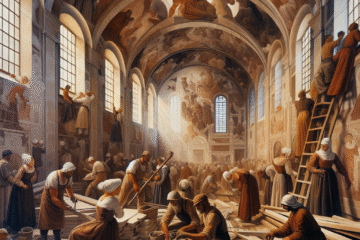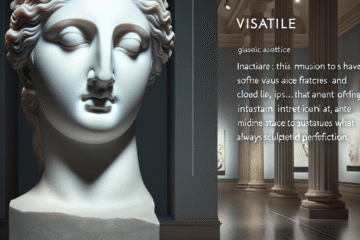Introduction: Rethinking the Baroque
When we speak of the Baroque, images of opulent cathedrals in Rome, shadow-laden canvases by Caravaggio, or the grandeur of Versailles often spring to mind. Yet, Baroque was never just a European phenomenon. As empires expanded, trade flourished, and missionaries traveled, the Baroque style traversed continents—morphing, adapting, and merging with local traditions in astonishing ways. What emerges is a picture of a fluid artistic language, simultaneously global and deeply local. This article follows the journey of Baroque aesthetics through Latin America, India, and Southeast Asia, revealing how this dramatic and sensuous style was transformed far beyond its European origins.
Chapter 1: The Baroque DNA – Origins and Motifs
The Baroque period, spanning roughly from the late 16th to the early 18th century, arose in post-Reformation Europe as a means of restoring the Catholic Church’s prestige through sensory appeal. Characterized by dynamic compositions, intense contrasts of light and shadow, ornate decoration, and emotional exuberance, Baroque art and architecture were meant to move souls and communicate divine authority. But as European powers such as Spain, Portugal, and the Netherlands engaged in colonial expansion, they brought this aesthetic doctrine across oceans and into vastly different cultural terrains.
From churches to palaces, from oil paintings to wood carvings, Baroque visual language was introduced as a tool not only of religious instruction but also of imperial symbolism. However, as it encountered local beliefs, materials, and iconographies, this visual language evolved in surprising and innovative ways.
Chapter 2: The New World Splendor – Latin America’s Baroque Synthesis
Nowhere was the Baroque more flamboyantly transformed than in Latin America. In colonial Mexico and Peru, local artisans, often trained in European techniques yet deeply rooted in indigenous traditions, gave rise to what scholars now call the “Andean Baroque” or “Mexican Baroque.” These styles exploded with color, natural motifs, and a sense of theatricality that surpassed their European counterparts.
Take the Church of San Francisco in Quito, Ecuador, a masterpiece where gilded altarpieces burst with angels and floral arabesques rooted as much in Quechua symbolism as in Catholic doctrine. Or the Cathedral of Puebla in Mexico, where stucco and tilework combine Spanish, Moorish, and indigenous techniques. The European concept of a centralized, controlling style gave way to a hybridized aesthetic, in which the Baroque became a visual space for negotiation between cultures, often mediated by mestizo artists and artisans.
Chapter 3: Baroque India – Jesuits, Mughals, and Ornate Convergence
In India, the Baroque arrived through Portuguese missionaries and merchants, particularly in Goa—a tropical jewel in the crown of the Portuguese empire. Here, European religious imagery collided with an already rich tradition of Mughal and Deccani art. Goan churches like Bom Jesus Basilica showcase altars gilded in gold leaf, overflowing with rocaille scrolls and Cherubim that seem oddly at home amidst local architectural features like the multi-tiered shikhara or tiled roofs adapted to monsoon climates.
This Indo-Baroque was further enriched by Jesuit engagement with Mughal courts. Emissaries brought prints and paintings that fascinated emperors like Akbar and Jahangir, sparking artistic exchanges. The chiaroscuro and perspective techniques of European Baroque painting found limited yet intriguing expression in Indo-Islamic miniature painting of the time, suggesting a momentary aesthetic osmosis rather than a wholesale adoption of Baroque style.
Chapter 4: Southeast Asia’s Hybrid Devotions – The Viet and Filipino Baroque
In the Philippines, another Spanish colony, the confluence of Catholicism and native artistry gave rise to the “Earthquake Baroque,” especially in regions prone to tremors. Churches like San Agustin in Manila feature heavy-set, squat proportions aimed at stabilizing buildings against seismic activity. But it wasn’t just about function. Decorative schemes here are a riot of Asian and European motifs – dragons curl around Corinthian columns, while local hardwoods are carved into fantastical reliefs more reminiscent of the jungle than of sacred Rome.
Elsewhere in Southeast Asia, evidence of Jesuit influence in Vietnam and pockets of Thailand suggests subtler gestures towards Baroque ornamentation, often manifesting in devotional objects or in the rare surviving church facades that mix Asian rooflines with Western pilasters and icon niches.
Chapter 5: Philosophies in Play – The Sacred, the Profane, and the Political
Across these global translations of the Baroque, what remains fascinating is how the underlying philosophy of the style—its insistence on sensory overload as a passage to the divine—took on new meanings. In Europe, the Baroque aimed to reaffirm Catholic truth. In the colonies, it often acted as a double agent: while reinforcing imperial narratives, it also preserved and celebrated indigenous knowledge through iconography, craftmanship, and material use.
Technologically, the global movement of lithographs, pigments, and architectural blueprints meant that even remote regions were part of a web of aesthetic influence. But local makers were not passive recipients. Instead, they were deeply inventive, using available materials, integrating pre-colonial symbols, and tweaking the emotive power of the Baroque toward syncretic, sometimes subversive ends.
Conclusion: A World Refracted in Gold Leaf
The story of the Global Baroque is one of both expansion and transformation. It reminds us that art is not a monologue but a conversation — often messy, often asymmetrical, yet rich with unexpected harmonies. Far from being a purely European expression, the Baroque became a language spoken in many dialects, each reflecting the tensions, aspirations, and spiritual landscapes of its place. In peeling back the layers of this ornate, worldly style, we uncover not just cultural exchanges but also the resilience of local identities, surviving and thriving beneath the gilded surfaces.


